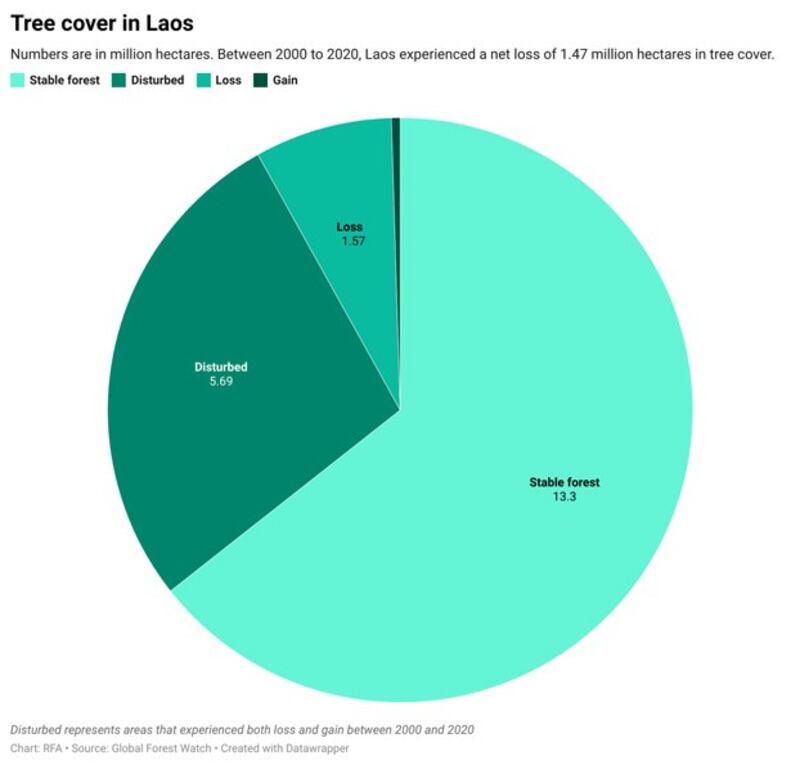The United States has agreed to provide funding and equipment to Laos to help combat illegal logging in its national protest forests, an official at the U.S. Embassy in Laos said.
Officials from the U.S. Forest Service’s International Program and the Lao Department of Forest Inspection signed a memorandum of understanding on Jan. 25, the embassy official, who did not want to be named, told RFA.
Their activities will focus mainly on preserving protected forest land in Champassak province in southwestern Laos, according to a post about the MOU on the embassy’s Facebook account.
Illegal logging has contributed to a range of environmental issues, including deforestation and biodiversity loss. It also reduces natural resources that nearby communities rely on and can lead to human rights abuses, violence and displacement.
But some Laotians involved in forest protection say the measure doesn’t get to the heart of the long-standing problem, and that a better solution would be to parcel out arable land to some of the offenders — people who live near protected forests. Many villagers in remote areas are poor and partially or completely landless, prompting them to encroach on state land such as national parks or forests.
Since the establishment of national protected forests in 1993, many poor landless families in Laos have encroached on these areas, which are rich in natural resources. Villages around the national protected forests have been growing quickly, so that there is not enough land for everyone to farm, Lao forestry officials said.
“We still see a lot of illegal logging and illegal wood trade in the national protected forests in the province, committed by some villagers who live near the forests,” a Lao project coordinator involved in U.S.-Laos cooperation project against illegal logging and trade told RFA, referring to Champassak province. Like others quoted in this report, he declined to give his name so he could speak freely about the project.

Under the agreement, the United States and Laos will work together to enact law enforcement strategies to reduce illegal logging and trade, especially in Champassak, home to two national protected forests near the Cambodian border — the 110,000-hectacre Dong Hua Sao National Protected Forest and the 240,000-hectare Xe Pian National Protected Forest.
The amount of US. funding and equipment for the 2023-2025 project has not been specified, an official from the Lao Ministry of Agriculture and Forestry said.
“The aid will be used to strengthen our law enforcement, forest inspection and patrol,” said the project coordinator.
Drones, computers and cameras
The U.S. forestry agency will provide computers, cameras and GPS drones so Lao forestry officials can monitor protected forests in Champassak’s Pathomphone, Khong and Mounlapamok districts near the Cambodian border, the project coordinator said.
The United States also will provide expertise and instruction to Lao authorities so they can step up law enforcement at the district and village levels, though American officials will not be involved in the actual on-the-ground crackdowns on illegal activities, he said. Lao officials will be responsible for this and for taking legal action against forest intruders.
Champassak has been a hotbed of illegal encroachment and logging on national protected forestland. In 2021, authorities in Khong district discovered that more than 300 families in a dozen villages had cleared nearly 400 hectares of land in Xe Pian National Protected Forest to farm and graze livestock.
The villagers cut down the trees and sold them, despite a central government decree that has banned all logging and trade, a Lao forestry official said.
Legal logging in Laos is only allowed in areas under development where roads or hydropower dams are being built.
Though the U.S. assistance will be helpful, it may not be the best solution to the land encroachment issue, which could be reduced by allocating some parcels to landless farmers living in the vicinity of protected forests, the forestry official said.
Many people live near the province’s protected forests and still engage in illegal logging, especially in the Dong Hua Sao National Protected Forest, he said.
“The locals cut down the trees, and then sell them to businesspeople,” he said.
An official from the Dong Houa Sao National Protected Forest agreed.
“Before, we patrolled the forests on foot, so we couldn’t cover much territory,” he said. “Now that we’ll have drones, we’ll be able to cover the whole area. We’ll see right away where the illegal logging takes place and go there immediately.”
Translated by Max Avary for RFA Lao. Edited by Roseanne Gerin and Malcolm Foster.
